Dr Vino's wine blog
wine talk that goes down easy
What do you want on a back label?
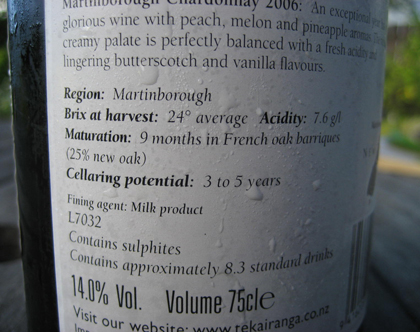
Yesterday’s post sparked a discussion about which words and/or information you really would like to have on a back label. While everyone can agree that pabulum (ahem, “handcrafted“) should end up in the dump bucket rather than the back label, what would you like to see?
A site reader sent in the above photo from New Zealand, which blends tech specs with some yadda yadda. Another small importer/distributor commented that half the people he asked actually wanted tasting notes on the back label. Do you want grape varieties on the back when place names only appear on the front? Even though about a quarter of wine consumers feel “overwhelmed” by wine, there’s still a strong case that, pace Mies van der Rohe, more is indeed more when it comes to useful information on the prime real estate of back labels.
Previously, we discussed Randall Grahm’s decision to bare all on his labels and that the FDA may push all producers in that direction. And don’t forget barcodes! So here it is, an omnibus thread for all your back label venting/discussion needs!
Please note that this post does not contain sulfites. And that you may operate machinery after reading it.
Back label watch: “handcrafted”

Usage of the term “handcrafted” on wine back labels is increasing.
In related news, the space for “machine crafted” on labels remains wide open. Read more…
Vent your spleen: wax seals on wine bottles
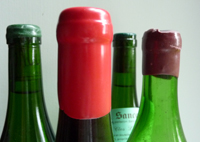 The other day we talked about “embarrassing moments in bottle opening.” Be sure to check out the stories for some good laughs.
The other day we talked about “embarrassing moments in bottle opening.” Be sure to check out the stories for some good laughs.
But one commenter who wasn’t laughing was Paul Gregutt, wine columnist for the Seattle Times. He had this to say:
there’s little doubt that the most difficult cork pulling experiences in my life come when someone has slathered their weapon-grade wine bottle with a pound or two of faux wax. You need a chainsaw to drill through some of these things. It is not helpful to embark on what is supposed to be a thoughtful review of someone’s wine with blood all over the corkscrew, the bottle, the glass and the writer. Perhaps you will join me in an effort to dissuade wineries from using this stuff?
I’ve enjoyed quite a few wines–from Lapierre, Foillard, Vatan, and Lopez de Heredia to name a few–sealed with a wax layer on top of the cork. While they are annoying since they require an additional sweep of the counter, I’ve never shed blood as Paul apparently has. And I think they do add a nice aesthetic touch.
But what say you? Should wineries no longer use them as Paul suggests?
[poll id=”6″]
Bonny Doon’s labels bare all – Randall Grahm, part I
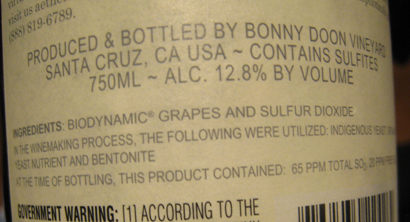
Spotted yesterday at a trade tasting: Bonny Doon’s labels are now baring all and putting a full “ingredient” list. This is not a legal requirement but more comprehensive labeling for wine is a subject that is in play. While more information on labels is a probably good thing, it would be helpful to have some context about some of lesser-known aspects of winemaking. But maybe that’s what the internet is for, researching things like wine ingredient lists. What do you think about more information on wine labels?
I asked Doonmaster Randall Grahm what prompted him to take this extra step. He said his reasoning was twofold. While admitting it was a little bit “pious” on his part, he said that he was doing it in part to encourage the industry to do more with less and to be more natural while “trumpeting our own virtue.” Further, he said that it is kind of an enforced discipline: “if you have to add it to the label, you think twice before doing anything.” He added, “It makes a better wine.”
Stay tuned for more with the Randall Grahm as I ask him about screwcaps and his new project!
In case you can’t read it from the blog-blurry photo of his 2008 Albarino (find this wine), here’s the text after the jump: Read more…
Do punny labels and good wine make a good blend? The case of Leitz
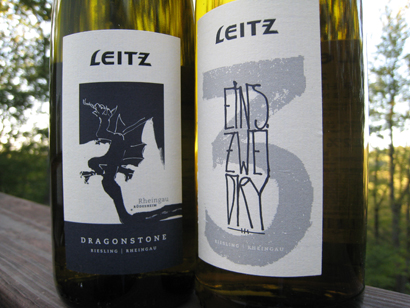
“I immediately assume that the wine is garbage if the punniness is high,” one of my friends said recently. Fair enough, as we have discussed before. But then there is the case of Johannes Leitz.
While many European labels can be confusing for New World consumers who are more used to varietal labeling, German labels crank up the degree of difficulty by adding terms such as Kabinett, Spaetlese, and–my favorite, linguistically–Trockenbeerenauslese. Although these terms express roughly the degree of sweetness, they only do so for the wine before fermentation (aka the weight of the must), so the level of residual sugar after fermentation may not be as sweet or dry as one might expect. Throw in some vineyard names on top of those terms and it makes running for Blue Nun understandable–from a purely linguistic standpoint.
Johannes Leitz, by contrast, makes some easy reading labels as well as tasty wines. He turned the Rudesheimer Drachenstein vineyard into simply “Dragonstone”–a cool label, easy name and easy drinking Riesling that I often recommend particularly as a wine for newbies. The single site, estate bottled wine is sweet in 2007 but obtains balance with some tangy acidity and minerality (find this wine). Pair with takeout.
New for 2007 is his multilingual punny “Eins, Zwei, Dry” (find this wine) The Riesling is, in fact, dry (well, 7 grams of residual sugar, barely above the threshold of perception). Dry Rieslings often seem to only come from the New World and Leitz only first produced this dry wine in the spectacular 2007 vintage (more details from the importer, Terry Theise’s page). The wine has more minerality and verve. I’d find this one most refreshing on a hot summer day with the Dragonstone one for the spring and the fall, when I prefer more richness.
Johannes Leitz has wit. And he makes clear labels good wines. He has my vote for federallabelminister! But I also think he is a rare exception, joining Rosenblum and possibly Bonny Doon, to the rule about puns and wine quality.
Do witty labels and good wine make a good blend? Or is the wine best left to do the talking?
Playboy wines: a whiff of silicone, airbrush, and softcore tannins
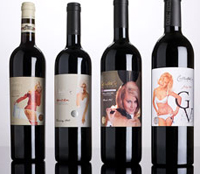 The Wall Street Journal recently got in the act of selling wines. Now Playboy doesn’t want to be left, um, behind.
The Wall Street Journal recently got in the act of selling wines. Now Playboy doesn’t want to be left, um, behind.
The magazine has collaborated to put “iconic images on a new limited-run collectors’ wine series,” according to a press release. Limited runs of wines will be “hand-chosen” by “credible master wine sommeliers who also were tasked with selecting the magazine cover that they feel best represents the flavor and taste profile of each wine.” Yikes, what an assignment!
But these are old wines in new, airbrushed wine skins with about 60 percent markups: The Schug Heritage Reserve Cabernet 2003 is easily available for under $50 (where to buy?) but with their label it is $86; the St. Supery Dollarhide Cabernet Sauvignon 2003 (where to buy?) is available for about $70 but with their label it is $112.
Their label for the Schug is particularly, erm, revealing; how did they get this by those dour, green-visored regulators at the Treasury Department? The “peel away” label no doubt helped. And to think that 1993 Mouton label by Balthus, a line drawing, was too much for them to approve.
After the jump, if you dare, click through for a comparison of the banned Mouton label with the current one from Playboy wines! Read more…
Vote now for the most groan-inducing wine name!
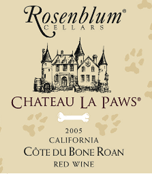 The groan committee has met! Thanks for your suggestions of the most groan-inducing wine name. There are many bad wine names out there but it was interesting that no fewer than three people observed that once they pulled the cork on the wine, it wasn’t half bad. Producers take note.
The groan committee has met! Thanks for your suggestions of the most groan-inducing wine name. There are many bad wine names out there but it was interesting that no fewer than three people observed that once they pulled the cork on the wine, it wasn’t half bad. Producers take note.
Here are the four “groan cru” (sorry, had to do it) wine names. Vote now for the worst offender! And remember, this isn’t for the worst label design, just the name, hence no finalist labels are shown to distract us.
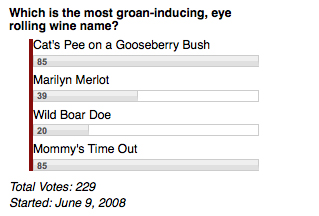
poll now closed
The most groan-inducing wine name
 What’s in a name? When it comes to wine, it’s quite often sales.
What’s in a name? When it comes to wine, it’s quite often sales.
Names, of course, don’t affect the taste. As the great wordsmith Shakespeare might have put it, a wine by another name would smell as dry with a hint of raspberry, leather, and garrigue. But sometimes the name can make us groan, roll our eyes, and not buy the bottle.
Consider Rosenblum Cellars’ Chateau La Paws Cote du Bone Roan red (about $14; find this wine). I’ve seen the wine on store shelves, groaned, and kept walking. But I recently tried it at a trade tasting and the heck if it isn’t purdy darned good! But I’d still never buy it. OK, maybe as a gift for my dog-loving sister-in-law. Once. Or for some other friends who are very into their adorable puppies. But only once then too. Moving on!
Which wines out there have the most groan-inducing names? (A Groan Cru, if you will.) Hit the comments with your thoughts. Next week, we’ll narrow the field and let the voting begin! And please note, this is for names only; the aesthetes had their say recently with the worst label design.



